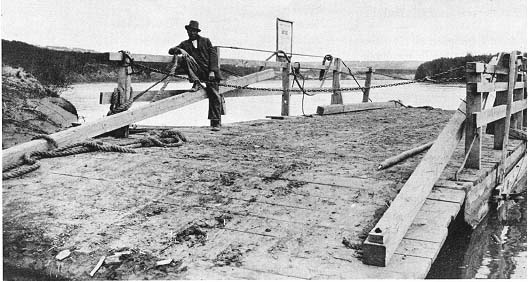The early fur traders in our area arrive by both canoe and horse although the canoe could move more goods up and down the river. Buckingham House built the first York boats and they became the way goods were moved in and out of the country by the HBC because they were more efficient.
Early settlers also came into the country from Edmonton often by scow drifting down the river so they could carry the supplies they needed to get started. Early ferries started at Lea Park, Hopkins, and Duverney. These ferries were far apart and so later other ferries sprung up in other locations: Desjarlais Crossing, Beauvallon, Lindbergh and Heinsburg. Here is a brief summary of these ferry sites.
HOPKINS CROSSING FERRY (1908-70) North Saskatchewan River 5/6-56-7-4
Local Dominion Land Surveyor Marshall Willard Hopkins surveyed the St. Paul area of the province about 1903-04, and the post settlement of Hopkins was named after him in 1908 when the post office was established at the Trading Store. A ferry was installed in 1908 to enable farmers to cross the river to the railway, and although the post office was discontinued in 1915, the ferry continued to operate as "Hopkins" until 1970, when the bridge at Myrnam was opened. It was a busy
crossing in the early years as it was the only ferry on the river in that area, until the Mooswa (Lindbergh) ferry was installed in 1911. The Hopkins ferry apparently operated safely and satisfactorily during its sixty-two years of service as there is no record of any serious mishaps; although it probably had its share of trouble due to high water periods and winter ice crossings.
One day in 1916 when the water was running high, a barn was seen floating down the river with three Jersey cows still inside. The ferryman, with a couple of helpers, took the ferry out into midstream, hoping to block the barn's journey, but they were just a few feet out and the barn merely glanced off the ferry and went on its way, the
three cows staring ahead calmly. On another occasion, someone tried to cross a herd of horses on the ice in winter, well strung out to that their weight would not break
the ice. Unluckily, when they were halfway across, the ice "boomed," as it often did when freezing, and the horses took fright and bunched together, all being drowned when the ice collapsed under their weight.
Leon Kobel, the last ferryman at Hopkins, spent a total of twenty-five years altogether in this job.
Haestie, Elizabeth Ferries and Ferrymen in Alberta, Glenbow Museum 1986
More information on Hopkins Ferry here: https://elkpointhistory.ca/growth/businesses/transportation/elk-point-ferries/hopkins-crossing-ferry-1908-70
Steve Andrisak https://elkpointhistory.ca/river-crossings-over-north-saskatchewan-river
Reflections info https://elkpointhistory.ca/elk-point-ferries
Charlie Magnusson https://elkpointhistory.ca/families/pioneer-families-arriving-1920/magnusson-charlie
Ole Martin Jacobson https://elkpointhistory.ca/families/pioneer-families-arriving-1920/jacobson-ole-martin

ELK POINT FERRY (1913-50) North Saskatchewan River SE25-56-7-4
Charlie Hood had a general store at Elk Point and also operated a scow across the river to assist settlers coming into the area after 1909. Although the name Elk Point was established in 1909, the crossing, in the vicinity of the old fur trading posts of Buckingham House and Fort George, was known locally as "Hood's Crossing" for many years.
The government built a ferry for this crossing in 1913 and floated it downriver from Edmonton, but as there were no accompanying barges to guide it, it floated right past the crossing and was used elsewhere. As a result, another ferry had to be built for Elk Point. As the area developed and more settlers arrived, it became a very busy
crossing. Stock days saw waiting line-ups over a mile long, with animals squealing and bellowing their protests on their way to the stockyards north of the river. In the evenings, wagons lined up to return on the ferry, laden with goods and supplies purchased with the stock cheques. Every fall, too, there was a desperate rush to get the
harvested grain across on the hardworking little ferry to the elevators before the river ice started to form.
Sometime in the 1930s, ferryman Alf Monkman and Dr. F. G. Miller, the local doctor, rigged up a platform known as the "Jigger," to be used in emergencies during spring and fall when the ferry could not be used. If Dr. Miller had to cross the river on an emergency call, he and Alf would crouch low on the "jigger" as it sped down the cable to the middle of the river, then stand up and haul themselves up the other half of the cable. While the doctor visited his patient, Alf would build a
fire and await the doctor's return, both repeating the crossing in the same way. Sometimes the doctor would be called out again the same night, and he and Alf would do the same thing all over again!
The government built and installed a larger "cage" for emergency crossings about 1935 - a much safer way of crossing, known locally as the "go-devil." This was used to transport mail and supplies and could also be used by passengers. About 1939, the "go-devil" loaded with a group of local boys fell about twenty feet on to the river ice, but fortunately none of the passengers was hurt.
Excerpt from Haestie, Elizabeth Ferries and Ferrymen in Alberta, Glenbow Museum 1986
Steve Andrisak https://elkpointhistory.ca/river-crossings-over-north-saskatchewan-river
Reflections info https://elkpointhistory.ca/elk-point-ferries
Charlie Magnusson https://elkpointhistory.ca/families/pioneer-families-arriving-1920/magnusson-charlie
Ole Martin Jacobson https://elkpointhistory.ca/families/pioneer-families-arriving-1920/jacobson-ole-martin



